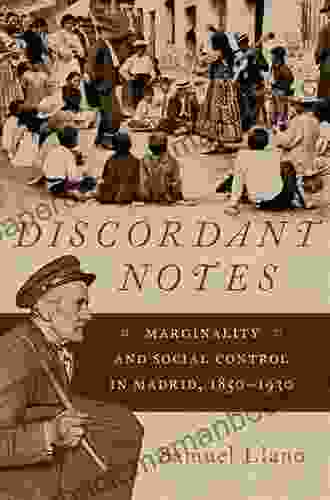Marginality and Social Control in Madrid: 1850-1930. Currents in Latin American Urban History.

5 out of 5
| Language | : | English |
| File size | : | 2523 KB |
| Text-to-Speech | : | Enabled |
| Enhanced typesetting | : | Enabled |
| Print length | : | 272 pages |
| Lending | : | Enabled |
| Screen Reader | : | Supported |
The concept of marginality has been widely used in social sciences to refer to the condition of individuals or groups who are excluded from the mainstream of society. This exclusion can be based on a variety of factors, such as poverty, race, ethnicity, sexual orientation, or disability. While marginality has often been seen as a negative condition, it can also be a source of resilience and creativity. Marginalized individuals and groups can develop their own cultures and social networks, which can provide them with a sense of belonging and support.
In the context of Madrid during the period 1850-1930, marginality was a complex and contested social category. The city was undergoing rapid urbanization and industrialization, which led to the influx of large numbers of migrants from rural areas. These migrants often found themselves living in貧民窟。 or shantytowns, and they faced discrimination and exclusion from the more established residents of the city.
The authorities in Madrid responded to the problem of marginality in a variety of ways. They built new housing projects for the poor, and they implemented social welfare programs to provide assistance to the needy. They also cracked down on crime and disorder in the貧民窟。. These measures were often ineffective, and they did little to improve the lives of the marginalized population.
The concept of marginality has been used in a variety of ways to understand the social and economic changes that occurred in Madrid during the period 1850-1930. Some scholars have argued that marginality was a product of the city's rapid urbanization and industrialization. Others have emphasized the role of social and political factors, such as discrimination and exclusion. Still others have seen marginality as a more positive force, arguing that it can lead to the development of new cultures and social networks.
The debate over the meaning of marginality is likely to continue for many years to come. However, there is no doubt that the concept is a valuable tool for understanding the social and economic history of Madrid during the period 1850-1930.
The Changing Meanings of Marginality
The meaning of marginality has changed over time. In the early 19th century, the term was used to refer to people who lived on the边缘of society. These people were often poor, homeless, and criminal. By the late 19th century, the meaning of marginality had expanded to include people who were excluded from the mainstream of society due to their race, ethnicity, religion, or sexual orientation.
In the context of Madrid during the period 1850-1930, marginality was a complex and contested social category. The city was undergoing rapid urbanization and industrialization, which led to the influx of large numbers of migrants from rural areas. These migrants often found themselves living in貧民窟。 or shantytowns, and they faced discrimination and exclusion from the more established residents of the city.
The authorities in Madrid responded to the problem of marginality in a variety of ways. They built new housing projects for the poor, and they implemented social welfare programs to provide assistance to the needy. They also cracked down on crime and disorder in the貧民窟。. These measures were often ineffective, and they did little to improve the lives of the marginalized population.
The changing meanings of marginality in Madrid during the period 1850-1930 reflect the changing social and economic conditions of the city. As the city grew and industrialized, the number of marginalized people increased. The authorities struggled to find effective ways to deal with this problem, and the resulting social tensions contributed to the city's political instability.
Social Control and Marginality
Social control is a set of mechanisms that are used to maintain order and stability in society. These mechanisms can include laws, regulations, and social norms. Social control can be exercised by the state, by religious institutions, or by other groups or organizations.
In the context of Madrid during the period 1850-1930, social control was used in a variety of ways to deal with the problem of marginality. The authorities built new housing projects for the poor, and they implemented social welfare programs to provide assistance to the needy. They also cracked down on crime and disorder in the貧民窟。. These measures were often ineffective, and they did little to improve the lives of the marginalized population.
The use of social control to deal with marginality was often counterproductive. The harsh measures that were used to crack down on crime and disorder in the貧民窟。 often alienated the marginalized population and made them more resistant to the authorities. The social welfare programs that were implemented were often inadequate and did little to improve the lives of the poor. As a result, social control often exacerbated the problem of marginality rather than solving it.
The concept of marginality is a complex and contested one. It has been used in a variety of ways to understand the social and economic changes that occurred in Madrid during the period 1850-1930. Some scholars have argued that marginality was a product of the city's rapid urbanization and industrialization. Others have emphasized the role of social and political factors, such as discrimination and exclusion. Still others have seen marginality as a more positive force, arguing that it can lead to the development of new cultures and social networks.
The debate over the meaning of marginality is likely to continue for many years to come. However, there is no doubt that the concept is a valuable tool for understanding the social and economic history of Madrid during the period 1850-1930.
5 out of 5
| Language | : | English |
| File size | : | 2523 KB |
| Text-to-Speech | : | Enabled |
| Enhanced typesetting | : | Enabled |
| Print length | : | 272 pages |
| Lending | : | Enabled |
| Screen Reader | : | Supported |
Do you want to contribute by writing guest posts on this blog?
Please contact us and send us a resume of previous articles that you have written.
 Top Book
Top Book Novel
Novel Fiction
Fiction Nonfiction
Nonfiction Literature
Literature Paperback
Paperback Hardcover
Hardcover E-book
E-book Audiobook
Audiobook Bestseller
Bestseller Classic
Classic Mystery
Mystery Thriller
Thriller Romance
Romance Fantasy
Fantasy Science Fiction
Science Fiction Biography
Biography Memoir
Memoir Autobiography
Autobiography Poetry
Poetry Drama
Drama Historical Fiction
Historical Fiction Self-help
Self-help Young Adult
Young Adult Childrens Books
Childrens Books Graphic Novel
Graphic Novel Anthology
Anthology Series
Series Encyclopedia
Encyclopedia Reference
Reference Guidebook
Guidebook Textbook
Textbook Workbook
Workbook Journal
Journal Diary
Diary Manuscript
Manuscript Folio
Folio Pulp Fiction
Pulp Fiction Short Stories
Short Stories Fairy Tales
Fairy Tales Fables
Fables Mythology
Mythology Philosophy
Philosophy Religion
Religion Spirituality
Spirituality Essays
Essays Critique
Critique Commentary
Commentary Glossary
Glossary Bibliography
Bibliography Index
Index Table of Contents
Table of Contents Preface
Preface Introduction
Introduction Foreword
Foreword Afterword
Afterword Appendices
Appendices Annotations
Annotations Footnotes
Footnotes Epilogue
Epilogue Prologue
Prologue Renee Patterson
Renee Patterson Stein Willard
Stein Willard Nina Du Thaler
Nina Du Thaler Maryann Jacobsen
Maryann Jacobsen Bernard Cornwell
Bernard Cornwell Lisa Hedberg
Lisa Hedberg Kim Solga
Kim Solga Vince Flynn
Vince Flynn Lisa Cobble
Lisa Cobble Kanji Okamoto
Kanji Okamoto H P Gentileschi
H P Gentileschi Ryan Parrott
Ryan Parrott Sara Driscoll
Sara Driscoll Pete Castillo
Pete Castillo Gus Van Auden
Gus Van Auden Lee Conrad
Lee Conrad Rui Zhi Dong
Rui Zhi Dong Larry Hite
Larry Hite Marsha Rice
Marsha Rice Christine A Courtois
Christine A Courtois
Light bulbAdvertise smarter! Our strategic ad space ensures maximum exposure. Reserve your spot today!

 Jaime MitchellThe Laura Lea Balanced Cookbook: A Comprehensive Guide to Healthy Eating for...
Jaime MitchellThe Laura Lea Balanced Cookbook: A Comprehensive Guide to Healthy Eating for... Mason PowellFollow ·7.1k
Mason PowellFollow ·7.1k Hassan CoxFollow ·12.6k
Hassan CoxFollow ·12.6k Dallas TurnerFollow ·3.8k
Dallas TurnerFollow ·3.8k J.R.R. TolkienFollow ·6.4k
J.R.R. TolkienFollow ·6.4k D'Angelo CarterFollow ·18.7k
D'Angelo CarterFollow ·18.7k Jeremy MitchellFollow ·11.2k
Jeremy MitchellFollow ·11.2k Jack PowellFollow ·7.8k
Jack PowellFollow ·7.8k David Foster WallaceFollow ·5k
David Foster WallaceFollow ·5k

 Jeremy Mitchell
Jeremy MitchellPlay We Now On Christmas Violin Christmas: A Heartfelt...
Play We Now On...

 Terry Bell
Terry BellTales from the Road: Confessions of an Atlanta Uber...
In the vibrant...

 Ervin Bell
Ervin BellThe French Admiral: A Gripping Naval Adventure with Alan...
In the vast expanse of...

 Henry David Thoreau
Henry David ThoreauCrochet Cozy Afghan Patterns: Crochet Weekend Afghan...
to Crochet...

 Orson Scott Card
Orson Scott CardAn Archaeological View Of The Industrialization Of North...
The industrialization of North America was a...

 Josh Carter
Josh CarterClipboard Christmas Skits by Tom Spence: A Festive...
A Christmas...
5 out of 5
| Language | : | English |
| File size | : | 2523 KB |
| Text-to-Speech | : | Enabled |
| Enhanced typesetting | : | Enabled |
| Print length | : | 272 pages |
| Lending | : | Enabled |
| Screen Reader | : | Supported |










